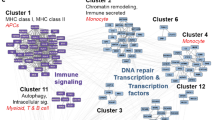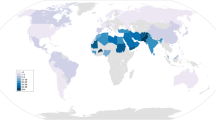Abstract
Stroke is the third leading cause of death and the leading cause of severe long-term disability in developed countries. Despite significant progress in understanding the risk factors conferring disease predisposition, the genetic and molecular basis of stroke remains poorly understood. Recent advances in the identification and characterization of patterns of DNA sequence variation in human populations hold the promise that stroke genomics will offer significant insights into disease pathophysiology and open new avenues for the development of novel therapeutic modalities. However, beyond single nucleotide polymorphisms, the emergence of additional sources of genomic variability as major factors in disease etiology is likely to transform our DNA-centric approaches toward more integrative and comprehensive strategies. This review provides an overview of the current progress and future prospects of the application of genomic sciences to stroke research.
Similar content being viewed by others
References and Recommended Reading
Mackay J, Mensah GA: The Atlas of Heart Disease and Stroke. Geneva, Switzerland: World Health Organization Publication; 2004.
Rosamond W, Flegal K, Furie K, et al.: Heart disease and stroke statistics-2008 update: a report from the American Heart Association Statistics Committee and Stroke Statistics Subcommittee. Circulation 2008, 117:e25–146.
Flossmann E, Schulz UG, Rothwell PM: Systematic review of methods and results of studies of the genetic epidemiology of ischemic stroke. Stroke 2004, 35:212–227.
Schulz UG, Flossmann E, Rothwell PM: Heritability of ischemic stroke in relation to age, vascular risk factors, and subtypes of incident stroke in population-based studies. Stroke 2004, 35:819–824.
Touze E, Rothwell PM: Sex differences in heritability of ischemic stroke: a systematic review and meta-analysis. Stroke 2008, 39:16–23.
Jerrard-Dunne P, Cloud G, Hassan A, et al.: Evaluating the genetic component of ischemic stroke subtypes: a family history study. Stroke 2003, 34:1364–1369.
Polychronopoulos P, Gioldasis G, Ellul J, et al.: Family history of stroke in stroke types and subtypes. J Neurol Sci 2002, 195:117–122.
Meschia JF, Brown RD Jr, Brott TG, et al.: Feasibility of an affected sibling pair study in ischemic stroke: results of a 2-center family history registry. Stroke 2001, 32:2939–2941.
Wiklund PG, Brown WM, Brott TG, et al.: Lack of aggregation of ischemic stroke subtypes within affected sibling pairs. Neurology 2007, 68:427–431.
Gretarsdottir S, Sveinbjornsdottir S, Jonsson HH, et al.: Localization of a susceptibility gene for common forms of stroke to 5q12. Am J Hum Genet 2002, 70:593–603.
Carmelli D, DeCarli C, Swan GE, et al.: Evidence for genetic variance in white matter hyperintensity volume in normal elderly male twins. Stroke 1998, 29:1177–1181.
Fox CS, Polak JF, Chazaro I, et al.: Genetic and environmental contributions to atherosclerosis phenotypes in men and women: heritability of carotid intima-media thickness in the Framingham Heart Study. Stroke 2003, 34:397–401.
Turner ST, Jack CR, Fornage M, et al.: Heritability of leukoaraiosis in hypertensive sibships. Hypertension 2004, 43:483–487.
Atwood LD, Wolf PA, Heard-Costa NL, et al.: Genetic variation in white matter hyperintensity volume in the Framingham Study. Stroke 2004, 35:1609–1613.
Flossmann E: Genetics of ischaemic stroke; single gene disorders. Int J Stroke 2006, 1:131–139.
Joutel A, Vahedi K, Corpechot C, et al.: Strong clustering and stereotyped nature of Notch3 mutations in CADASIL patients. Lancet 1997, 350:1511–1515.
Gretarsdottir S, Thorleifsson G, Reynisdottir ST, et al.: The gene encoding phosphodiesterase 4D confers risk of ischemic stroke. Nat Genet 2003, 35:131–138.
Helgadottir A, Manolescu A, Thorleifsson G, et al.: The gene encoding 5-lipoxygenase activating protein confers risk of myocardial infarction and stroke. Nat Genet 2004, 36:233–239.
Rosand J, Bayley N, Rost N, et al.: Many hypotheses but no replication for the association between PDE4D and stroke. Nat Genet 2006, 38:1091–1092; author reply 1092–1093.
Helgadottir A, Gretarsdottir S, St Clair D, et al.: Association between the gene encoding 5-lipoxygenase-activating protein and stroke replicated in a Scottish population. Am J Hum Genet 2005, 76:505–509.
Kaushal R, Pal P, Alwell K, et al.: Association of ALOX5AP with ischemic stroke: a population-based case-control study. Hum Genet 2007, 121:601–607.
Meschia JF, Brott TG, Brown RD Jr, et al.: Phosphodiesterase 4D and 5-lipoxygenase activating protein in ischemic stroke. Ann Neurol 2005, 58:351–361.
Zee RY, Cheng S, Hegener HH, et al.: Genetic variants of arachidonate 5-lipoxygenase-activating protein, and risk of incident myocardial infarction and ischemic stroke: a nested case-control approach. Stroke 2006, 37:2007–2011.
Turner ST, Fornage M, Jack CR Jr, et al.: Genomic Susceptibility Loci for Brain Atrophy in Hypertensive Sibships From the GENOA Study. Hypertension 2005, 45:793–798.
DeStefano AL, Atwood LD, Massaro JM, et al.: Genome-wide scan for white matter hyperintensity: the Framingham Heart Study. Stroke 2006, 37:77–81.
Fox CS, Cupples LA, Chazaro I, et al.: Genomewide linkage analysis for internal carotid artery intimal medial thickness: evidence for linkage to chromosome 12. Am J Hum Genet 2004, 74:253–261.
Bersano A, Ballabio E, Bresolin N, et al.: Genetic polymorphisms for the study of multifactorial stroke. Hum Mutat 2008, 29:776–795.
Ariyaratnam R, Casas JP, Whittaker J, et al.: Genetics of ischaemic stroke among persons of non-European descent: a meta-analysis of eight genes involving approximately 32,500 individuals. PLoS Med 2007, 4:e131.
Hindorff LA, Junkins HA, Mehta JP, et al.: A catalog of published genome-wide association studies. Available at http://www.genome.gov/gwastudies. Accessed November 15, 2008.
Gretarsdottir S, Thorleifsson G, Manolescu A, et al.: Risk variants for atrial fibrillation on chromosome 4q25 associate with ischemic stroke. Ann Neurol 2008, 64:402–409.
Matarin M, Brown WM, Scholz S, et al.: A genome-wide genotyping study in patients with ischaemic stroke: initial analysis and data release. Lancet Neurol 2007, 6:414–420.
Manolio TA, Bailey-Wilson JE, Collins FS: Genes, environment and the value of prospective cohort studies. Nat Rev Genet 2006, 7:812–820.
Larson MG, Atwood LD, Benjamin EJ, et al.: Framingham Heart Study 100K project: genome-wide associations for cardiovascular disease outcomes. BMC Med Genet 2007, 8(Suppl 1):S5.
Seshadri S, DeStefano AL, Au R, et al.: Genetic correlates of brain aging on MRI and cognitive test measures: a genomewide association and linkage analysis in the Framingham study. BMC Genetics 2007, 8(Suppl 1):S1–S15.
Psaty BM, O’Donnell CJ, Gudnason V, et al.: Cohorts for Heart and Aging Research in Genomic Epidemiology (CHARGE) Consortium: design of prospective meta-analyses of genome-wide association studies from five cohorts. Circulation: Cardiovascular Genetics 2009 (in press).
Cole JW, Brown DW, Giles WH, et al.: Ischemic stroke risk, smoking, and the genetics of inflammation in a biracial population: the stroke prevention in young women study. Thromb J 2008, 6:11.
Klein RJ, Zeiss C, Chew EY, et al.: Complement factor H polymorphism in age-related macular degeneration. Science 2005, 308:385–389.
Anderson CA, Pettersson FH, Barrett JC, et al.: Evaluating the effects of imputation on the power, coverage, and cost efficiency of genome-wide SNP platforms. Am J Hum Genet 2008, 83:112–119.
Ionita-Laza I, Rogers AJ, Lange C, et al.: Genetic association analysis of copy-number variation (CNV) in human disease pathogenesis. Genomics 2009, 93:22–26.
Zhang J, Feuk L, Duggan GE, et al.: Development of bioinformatics resources for display and analysis of copy number and other structural variants in the human genome. Cytogenet Genome Res 2006, 115:205–214.
McCarroll SA, Altshuler DM: Copy-number variation and association studies of human disease. Nat Genet 2007, 39: S37–S42.
Matarin M, Simon-Sanchez J, Fung HC, et al.: Structural genomic variation in ischemic stroke. Neurogenetics 2008, 9:101–108.
Cheung VG, Conlin LK, Weber TM, et al.: Natural variation in human gene expression assessed in lymphoblastoid cells. Nat Genet 2003, 33:422–425.
Schadt EE, Monks SA, Drake TA, et al.: Genetics of gene expression surveyed in maize, mouse and man. Nature 2003, 422:297–302.
Jansen RC, Nap JP: Genetical genomics: the added value from segregation. Trends Genet 2001, 17:388–391.
Kalman J, Kitajka K, Pakaski M, et al.: Gene expression profile analysis of lymphocytes from Alzheimer’s patients. Psychiatr Genet 2005, 15:1–6.
Ricciarelli R, d’Abramo C, Massone S, et al.: Microarray analysis in Alzheimer’s disease and normal aging. IUBMB Life 2004, 56:349–354.
Borovecki F, Lovrecic L, Zhou J, et al.: Genome-wide expression profiling of human blood reveals biomarkers for Huntington’s disease. Proc Natl Acad Sci U S A 2005, 102:11023–11028.
Bomprezzi R, Ringner M, Kim S, et al.: Gene expression profile in multiple sclerosis patients and healthy controls: identifying pathways relevant to disease. Hum Mol Genet 2003, 12:2191–2199.
Scherzer CR, Eklund AC, Morse LJ, et al.: Molecular markers of early Parkinson’s disease based on gene expression in blood. Proc Natl Acad Sci U S A 2007, 104:955–960.
Du X, Tang Y, Xu H, et al.: Genomic profiles for human peripheral blood T cells, B cells, natural killer cells, monocytes, and polymorphonuclear cells: comparisons to ischemic stroke, migraine, and Tourette syndrome. Genomics 2006, 87:693–703.
Moore DF, Li H, Jeffries N, et al.: Using peripheral blood mononuclear cells to determine a gene expression profile of acute ischemic stroke: a pilot investigation. Circulation 2005, 111:212–221.
Tang Y, Xu H, Du X, et al.: Gene expression in blood changes rapidly in neutrophils and monocytes after ischemic stroke in humans: a microarray study. J Cereb Blood Flow Metab 2006, 26:1089–1102.
Xu H, Tang Y, Liu DZ, et al.: Gene expression in peripheral blood differs after cardioembolic compared with large-vessel atherosclerotic stroke: biomarkers for the etiology of ischemic stroke. J Cereb Blood Flow Metab 2008, 28:1320–1328.
Simpson JE, Hosny O, Wharton SB, et al.: Microarray RNA expression analysis of cerebral white matter lesions reveals changes in multiple functional pathways. Stroke 2009, 40:369–375.
Sullivan PF, Fan C, Perou CM: Evaluating the comparability of gene expression in blood and brain. Am J Med Genet B Neuropsychiatr Genet 2006, 141B:261–268.
Morley M, Molony CM, Weber TM, et al.: Genetic analysis of genome-wide variation in human gene expression. Nature 2004, 430:743–747.
Dixon AL, Liang L, Moffatt MF, et al.: A genome-wide association study of global gene expression. Nat Genet 2007, 39:1202–1207.
Emilsson V, Thorleifsson G, Zhang B, et al.: Genetics of gene expression and its effect on disease. Nature 2008, 452:423–428.
Goring HH, Curran JE, Johnson MP, et al.: Discovery of expression QTLs using large-scale transcriptional profiling in human lymphocytes. Nat Genet 2007, 39:1208–1216.
Kosik KS: The neuronal microRNA system. Nat Rev Neurosci 2006, 7:911–920.
Jeyaseelan K, Lim KY, Armugam A: MicroRNA expression in the blood and brain of rats subjected to transient focal ischemia by middle cerebral artery occlusion. Stroke 2008, 39:959–966.
Hatchwell E, Greally JM: The potential role of epigenomic dysregulation in complex human disease. Trends Genet 2007, 23:588–595.
Jaenisch R, Bird A: Epigenetic regulation of gene expression: how the genome integrates intrinsic and environmental signals. Nat Genet 2003, 33(Suppl):245–254.
Endres M, Meisel A, Biniszkiewicz D, et al.: DNA methyltransferase contributes to delayed ischemic brain injury. J Neurosci 2000, 20:3175–3181.
Faraco G, Pancani T, Formentini L, et al.: Pharmacological inhibition of histone deacetylases by suberoylanilide hydroxamic acid specifically alters gene expression and reduces ischemic injury in the mouse brain. Mol Pharmacol 2006, 70:1876–1884.
Barker DJ, Bagby SP, Hanson MA: Mechanisms of disease: in utero programming in the pathogenesis of hypertension. Nat Clin Pract Nephrol 2006, 2:700–707.
Hypponen E, Leon DA, Kenward MG, et al.: Prenatal growth and risk of occlusive and haemorrhagic stroke in Swedish men and women born 1915-29: historical cohort study. BMJ 2001, 323:1033–1034.
Eriksson JG, Forsen T, Tuomilehto J, et al.: Early growth, adult income, and risk of stroke. Stroke 2000, 31:869–874.
Post WS, Goldschmidt-Clermont PJ, Wilhide CC, et al.: Methylation of the estrogen receptor gene is associated with aging and atherosclerosis in the cardiovascular system. Cardiovasc Res 1999, 43:985–991.
Westberry JM, Prewitt AK, Wilson ME: Epigenetic regulation of the estrogen receptor alpha promoter in the cerebral cortex following ischemia in male and female rats. Neuroscience 2008, 152:982–989.
Author information
Authors and Affiliations
Corresponding author
Rights and permissions
About this article
Cite this article
Fornage, M. Genetics of stroke. Curr Atheroscler Rep 11, 167–174 (2009). https://doi.org/10.1007/s11883-009-0027-5
Published:
Issue Date:
DOI: https://doi.org/10.1007/s11883-009-0027-5




